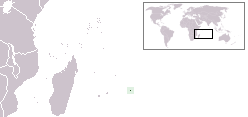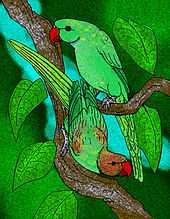Rodrigues Parrot
| Rodrigues Parrot | |
|---|---|
 | |
| Subfossil skull and limb bones, 1879 | |
| Conservation status | |
| Scientific classification | |
| Kingdom: | Animalia |
| Phylum: | Chordata |
| Class: | Aves |
| Order: | Psittaciformes |
| Family: | Psittaculidae |
| Subfamily: | Psittaculinae |
| Tribe: | Psittaculini |
| Genus: | Necropsittacus Milne-Edwards, 1874 |
| Species: | N. rodericanus |
| Binomial name | |
| Necropsittacus rodericanus (Milne-Edwards, 1867) | |
 | |
| Former range | |
| Synonyms | |
| |
The Rodrigues Parrot (Necropsittacus rodericanus) is an extinct parrot in the family Psittaculidae. It was endemic to the Mascarene island of Rodrigues in the Indian Ocean east of Madagascar. It is unclear what other species it is most closely related to, but it has been classified as a member of the tribe Psittaculini, along with other Mascarene parrots. It had similarities with the Broad-billed Parrot, and may have been closely related.
The Rodrigues Parrot was green, and had a proportionally large head and beak along with a long tail. Its exact size is unknown, but it may have been around 50 cm (20 in) long. It may have looked similar to the Great-billed Parrot. It frequented and nested on islets off southern Rodrigues to avoid introduced rats, and fed on the seeds of the Fernelia buxifolia shrub. The species is known from subfossil bones and from mentions in three contemporary accounts. It was last mentioned in 1761, and probably went extinct soon after. This was probably due to a combination of predation by rats, deforestation, and hunting by humans.
Taxonomy

Parrots matching the Rodrigues Parrot were first mentioned by François Leguat in 1708 and Julien Tafforet in 1726, who were both marooned on Rodrigues.[2] The parrot was scientifically described as Psittacus rodericanus by the French ornithologist Alphonse Milne-Edwards in 1867.[3] He moved it to its own genus in 1874. The binomial, Necropsittacus rodericanus, translates to "dead parrot of Rodrigues", in reference to its extinction. The holotype specimen is a subfossil partial beak, but its current whereabouts are unknown. It may be specimen UMZC 575, a rostrum that was sent from Milne-Edwards' to Alfred Newton after 1880, which matches the drawing and description in Milne-Edwards' paper, but this cannot be confirmed. In addition, subfossil remains of at least four individuals have been found in the Plaine Corail.[4]
After examining a skull of the Rodrigues Parrot, Edward Newton and Hans Gadow found it to be closely related to the Broad-billed Parrot due to their large jaws and other osteological features, but were unable to determine whether they both belonged in the same genus, since a crest was only known from the latter.[5] The skeleton also has similarities with the Tanygnathus and Psittacula parrot genera.[4]
In his 1907 book Extinct Birds, Walther Rothschild placed two hypothetical parrot species in the Necropsittacus genus; the Réunion Parrot (Necropsittacus? borbonicus) and the Mauritian Parrot (Necropsittacus? francicus').[6] The former was based on a single account by Sieur Dubois, and it is uncertain what the source for the latter is, so both are considered dubious today.[7]
Evolution
Many endemic Mascarene birds, including the Dodo, are derived from South Asian ancestors, and the English palaeontologist Julian Hume has proposed that this may be the case for all the parrots there as well. Sea levels were lower during the Pleistocene, so it was possible for species to colonise some of the then less isolated islands.[8] Although most extinct parrot species of the Mascarenes are poorly known, subfossil remains show that they shared features such as enlarged heads and jaws, reduced pectoral bones, and robust leg bones.[4]
Hume has suggested that they have a common origin in the radiation of the Psittaculini tribe, basing his theory on morphological features and the fact that Psittacula parrots have managed to colonise many isolated islands in the Indian Ocean.[4] The Psittaculini may have invaded the area several times, as many of the species were so specialised that they may have evolved significantly on hotspot islands before the Mascarenes emerged from the sea.[8] A 2011 genetic study instead found that the Mascarene Parrot (Mascarinus mascarinus) of nearby Réunion was most closely related to the Lesser Vasa Parrot (Coracopsis nigra) from Madagascar and nearby islands, and therefore unrelated to the Psittacula parrots, undermining the theory of their common origin.[9]
Description

The Rodrigues Parrot was described as large and with a big head and a long tail.[4] Its plumage was described as being of uniform green colouration.[10] Its skull was flat and depressed compared to those of most other parrots, but similar to the genus Ara. The skull was 50 mm (2.0 in) long without the beak, 38 mm (1.5 in) wide, and 24 mm (0.94 in) deep.[11] Its exact body length is unknown, but it may have been around 50 cm (20 in).[7] Its size has been likened to that of a large cockatoo.[12] Its tibia was 32% smaller than that of a female Broad-billed parrot, yet the pectoral bones were of similar size, and proportionally its head was the largest of any Mascarene species of parrot.[4]
The pectoral and pelvic bones were similar in size to those of the New Zealand Kaka (Nestor meridionalis), and it may have looked similar to the Great-billed Parrot (Tanygnathus megalorynchos) in life, but with a larger head and tail. It differed from other Mascarene parrots in several skeletal features, including having nostrils that faced upwards instead of forwards. No features of the skull suggest it had a crest like the Broad-billed Parrot, and there is not enough fossil evidence to determine whether it had pronounced sexual dimorphism.[4] There are intermediate specimens between the longest and shortest examples of the known skeletal elements, which indicates there were no distinct size groups.[11]
Behaviour and ecology

Tafforet's 1726 description is the only detailed account of the Rodrigues Parrot in life:
The largest are larger than a pigeon, and have a tail very long, the head large as well as the beak. They mostly come on the islets which are to the south of the island, where they eat a small black seed, which produces a small shrub whose leaves have the smell of the orange tree, and come to the mainland to drink water... they have their plumage green. The “Bois de buis” [Fernelia buxifolia] is common there and very small. The perroquets eat the seeds.[4]
The shrub mentioned by Tafforet, Fernelia buxifolia, is endangered today, but was common all over Rodrigues and nearby islets during his visit. At this time, the parrots, the Rodrigues Starling and the Rodrigues Pigeon frequented and nested on these islets to avoid the large population of introduced rats on Rodrigues.[4]
Many other of the endemic species of Rodrigues became extinct after the arrival of man, so the ecosystem of the island is heavily damaged. Before humans arrived, forests covered the island entirely, but very little remains today due to deforestation. The Rodrigues Parrot lived alongside other recently extinct birds such as the Rodrigues Solitaire, the Rodrigues Rail, Newton's Parakeet, the Rodrigues Starling, the Rodrigues Owl, the Rodrigues Night Heron, and the Rodrigues Pigeon. Extinct reptiles include the domed Rodrigues giant tortoise, the saddle-backed Rodrigues giant tortoise, and the Rodrigues day gecko.[8]
Extinction

Of the eight or so parrot species endemic to the Mascarenes, only the Mauritius Parakeet (Psittacula echo) has survived. The others were likely all made extinct by a combination of excessive hunting and deforestation. The offshore islets of Rodrigues were eventually infested by rats as well, and this is believed to be the reason for the demise of the Rodrigues Parrot and other birds there.[4] The rats probably preyed on their eggs and chicks.[10] The French astronomer Alexandre Guy Pingré visited Rodriges to observe the 1761 transit of Venus.[10] He indicated that local species were popular game, and found that the Rodrigues Parrot was rare:
The perruche [Newton's Parakeet] seemed to me much more delicate [than the flying-fox]. I would not have missed any game from France if this one had been commoner in Rodrigues; but it begins to become rare. There are even fewer perroquets [Rodrigues Parrots], although there were once a big enough quantity according to François Leguat; indeed a little islet south of Rodrigues still retains the name Isle of Parrots [Isle Pierrot].[4]
Pingré also reported that the island was becoming deforested by tortoise hunters who set fires to clear vegetation. Along with direct hunting of the parrots, this likely led to a reduction in the population of Rodrigues Parrots. Pingré's account is the last known mention of the species, and it probably went extinct soon after.[4]
References
- ↑ BirdLife International (2012). "Necropsittacus rodericanus". IUCN Red List of Threatened Species. Version 2013.2. International Union for Conservation of Nature. Retrieved 26 November 2013.
- ↑ Cheke, A. S. (1987). "An ecological history of the Mascarene Islands, with particular reference to extinctions and introductions of land vertebrates". In Diamond (ed.), A. W. Studies of Mascarene Island Birds. Cambridge. pp. 44–47. doi:10.1017/CBO9780511735769.003. ISBN 978-0521113311.
- ↑ Milne-Edwards, A. (1867). "Mémoire sur un Psittacien fossile de l'Île Rodrigue". Annales Des Sciences Naturelles comprenant la zoologie (in French) 5: 145–156.
- ↑ 4.0 4.1 4.2 4.3 4.4 4.5 4.6 4.7 4.8 4.9 4.10 4.11 Hume, J. P. (2007). "Reappraisal of the parrots (Aves: Psittacidae) from the Mascarene Islands, with comments on their ecology, morphology, and affinities". Zootaxa 1513: 4–34.
- ↑ Newton, E.; Gadow, H. (1893). "IX. On additional bones of the Dodo and other extinct birds of Mauritius obtained by Mr. Theodore Sauzier". The Transactions of the Zoological Society of London 13 (7): 281–302. doi:10.1111/j.1469-7998.1893.tb00001.x.
- ↑ Rothschild, W. (1907). Extinct Birds. London: Hutchinson & Co. pp. 61–62.
- ↑ 7.0 7.1 Fuller, E. (2001). Extinct Birds (revised ed.). New York: Comstock. pp. 232–233. ISBN 978-0-8014-3954-4.
- ↑ 8.0 8.1 8.2 Cheke, A. S.; Hume, J. P. (2008). Lost Land of the Dodo: an Ecological History of Mauritius, Réunion & Rodrigues. New Haven and London: T. & A. D. Poyser. pp. 49–73. ISBN 978-0-7136-6544-4.
- ↑ Kundu, S.; Jones, C. G.; Prys-Jones, R. P.; Groombridge, J. J. (2011). "The evolution of the Indian Ocean parrots (Psittaciformes): Extinction, adaptive radiation and eustacy". Molecular Phylogenetics and Evolution 62 (1): 296–305. doi:10.1016/j.ympev.2011.09.025. PMID 22019932.
- ↑ 10.0 10.1 10.2 Hume, J. P.; Walters, M. (2012). Extinct Birds. London: A & C Black. pp. 178–179. ISBN 1-4081-5725-X.
- ↑ 11.0 11.1 Günther, A.; Newton, E. (1879). "The extinct birds of Rodriguez". Philosophical Transactions of the Royal Society of London 168: 423–437. doi:10.1098/rstl.1879.0043.
- ↑ Greenway, J. C. (1967). Extinct and Vanishing Birds of the World. New York: American Committee for International Wild Life Protection 13. p. 127. ISBN 0-486-21869-4.
